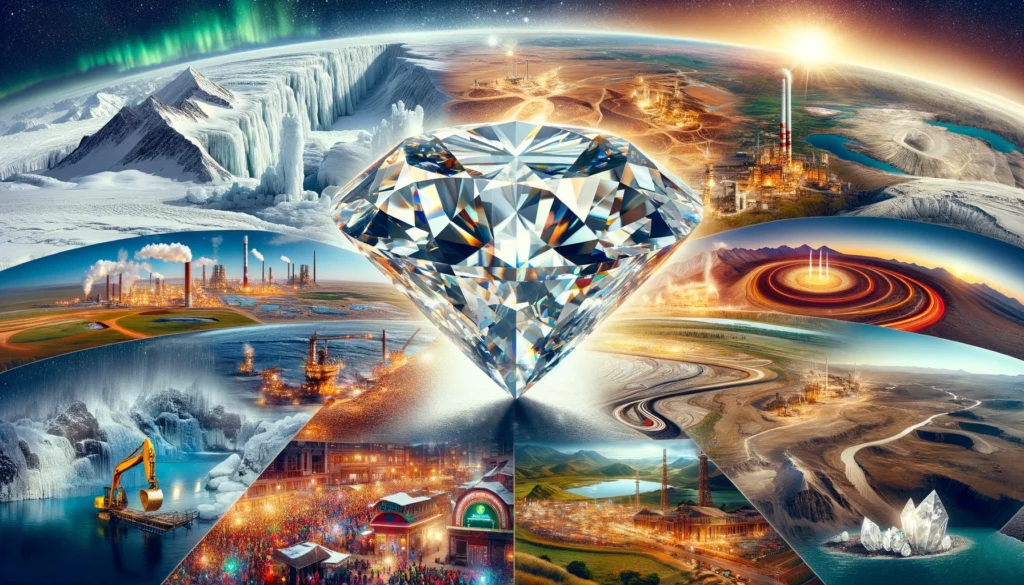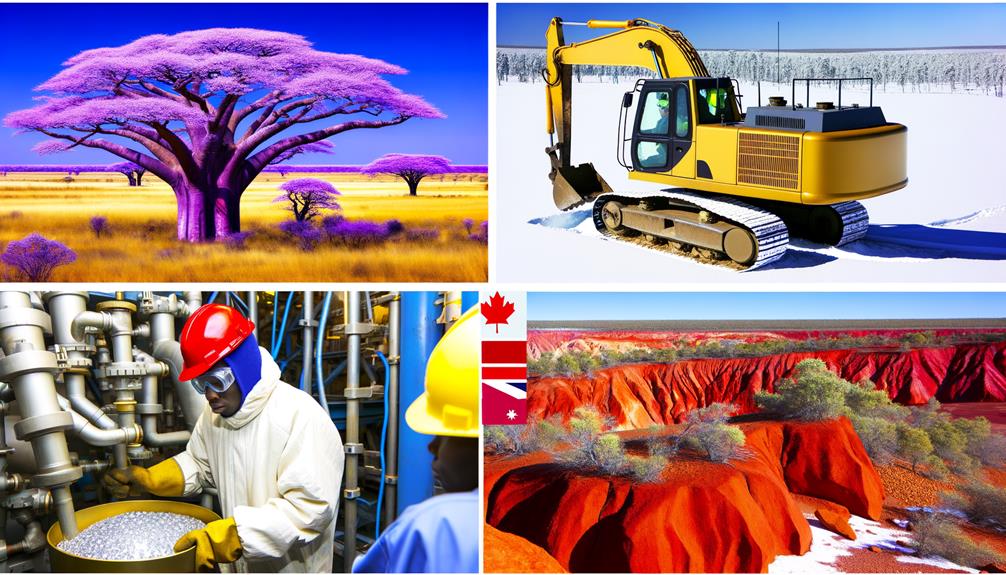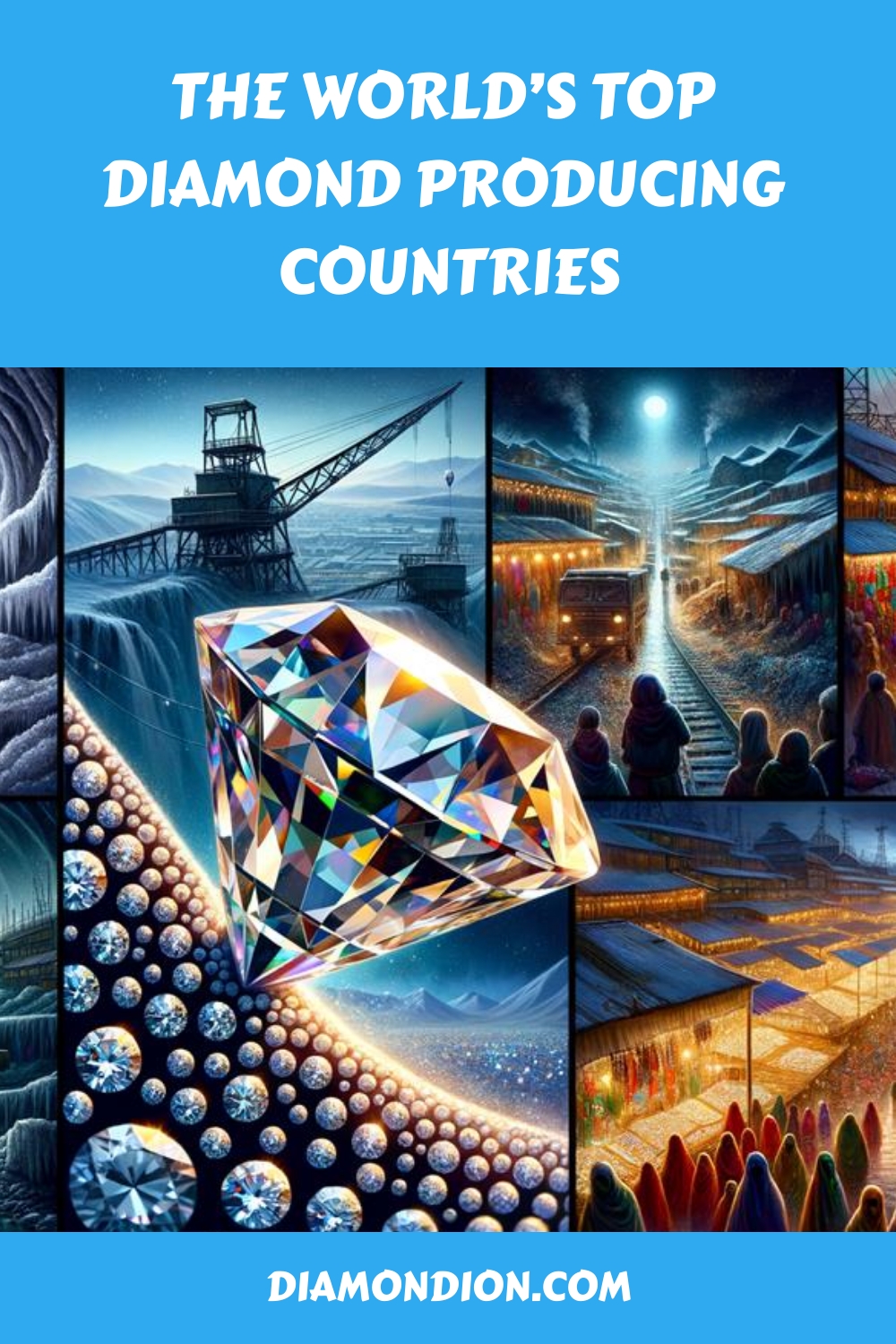Article Contents
- 1 Key Takeaways About the Top Diamond Producing Countries
- 2 Ranked Diamond Mining Countries
- 3 Rough Diamond Production
- 4 Diamond Mining by Country
- 5 Regions Producing the Most Diamonds
- 6 Energy in Diamond Production
- 7 Commodity Returns and Outlook
- 8 Frequently Asked Questions
- 9 Conclusion
- 10 Further Reading About The Top Diamond Producing Countries
Are you ready to embark on a journey through the glittering world of the top diamond producing countries and the facts behind the glittering prizes they unearth?
Step into the realm of the world’s top diamond-producing countries, where Russia, Botswana, the Democratic Republic of the Congo, Australia, and Canada reign supreme.
These countries hold the key to the global diamond industry, each with its own unique contribution to the dazzling world of diamonds.
From the vast reserves of Russia to the high-quality gems of Botswana and the untapped potential of the Democratic Republic of the Congo, there is so much to uncover.
And that’s just the beginning.
So, get ready to explore the secrets behind their glittering success and discover the fascinating stories that lie beneath the surface.
Key Takeaways About the Top Diamond Producing Countries
- Russia is the leading diamond mining country, with abundant reserves and being the largest exporter of rough diamonds.
- Botswana is known for its high-quality and large-sized diamonds.
- Africa is the largest rough diamond-producing region, with the Democratic Republic of the Congo being a major player in the diamond market.
- The diamond industry is exploring sustainable energy solutions to reduce its carbon footprint.
Ranked Diamond Mining Countries
Which countries are the top-ranked diamond mining countries in the world?
When it comes to diamond production, there are several countries that stand out.
Russia is the leading diamond mining country, with abundant reserves and being the largest exporter of rough diamonds.
Botswana is another top-ranked country, known for its high-quality and large-sized diamonds.
The Democratic Republic of Congo also deserves recognition, as it has the potential for increased production and is a significant player in the diamond industry.
Australia, on the other hand, is known for its production of natural colored diamonds, which adds a unique aspect to the global diamond market.
Finally, Canada, as the fifth-largest diamond mining country, contributes to the overall supply of diamonds in the world.
These countries have established themselves as key players in the diamond mining industry with their rich resources and significant contributions.
Rough Diamond Production

Russia leads the global rough diamond production, mining approximately 42 million carats in 2022. This makes Russia the largest producer of rough diamonds in the world. Its vast reserves and advanced mining operations support the country’s diamond industry.
Here are three key points about rough diamond production:
- Top Diamond-Producing Countries: Alongside Russia, Botswana and Canada are also significant producers of rough diamonds. These countries contribute significantly to the global diamond industry, with Botswana known for its high-quality and large-sized diamonds, while Canada ranks as the fifth-largest diamond mining country.
- Largest Mines: The top diamond-producing countries have large-scale mining operations that extract rough diamonds from deep within the earth. These mines utilize advanced technology and machinery to maximize production efficiency. Some notable mines include the Mirny Mine in Russia, the Jwaneng Mine in Botswana, and the Diavik Mine in Canada.
- Impact on Global Diamond Supply: These top diamond-producing countries’ production of rough diamonds greatly influences the global diamond supply. These countries collectively account for 99.2% of the total rough diamonds mined in 2022. Their production capabilities ensure a steady supply of rough diamonds for cutting, polishing, and eventual use in jewellery and industrial applications.
As rough diamond production continues to play a crucial role in the diamond industry, these top diamond-producing countries remain at the forefront, ensuring a steady supply of these precious gemstones. As global demand for diamonds persists, these nations work tirelessly to maintain efficient mining operations and develop sustainable practices to meet market needs. Meanwhile, the diamond industry’s downstream segment also witnesses significant growth, with retailers capitalizing on this supply to expand their footprint, such as the Malabar Gold expansion in UK, which demonstrates the increasing reach of jewelry brands into international markets. This strategic growth not only enhances accessibility for consumers but also solidifies the interconnected nature of the global gemstone trade. Despite the success and growth in the diamond industry, global diamond trade challenges persist, including issues related to conflict diamonds, ethical sourcing, and environmental impact. These challenges compel the industry to prioritize responsible and sustainable practices, transparency, and ethical sourcing to address consumer concerns and maintain a positive reputation. Additionally, collaboration among industry stakeholders, international organizations, and governments is crucial in addressing these challenges and ensuring the long-term viability of the global diamond trade. Supply chain challenges, such as the ethical sourcing of diamonds and environmental impact, have prompted industry leaders to prioritize responsible practices and establish rigorous certification systems. This push for transparency and sustainability not only benefits the environment and local communities but also serves to reassure consumers about the origins of their diamonds. By addressing these supply chain challenges head-on, the diamond industry can uphold its commitment to ethical sourcing and environmental stewardship while fostering trust and confidence among consumers.
Diamond Mining by Country
As we continue our investigation of diamond production, let’s look at the distribution of diamond mining by nation, emphasizing the significant role that the top diamond-producing countries play.
Russia, Botswana, the Democratic Republic of the Congo, Australia, and Canada are the top diamond mining countries, each contributing to the global diamond industry in their own distinct ways.
Russia stands as the largest rough diamond producer, mining approximately 42 million carats in 2022. Its vast reserves and position as the largest exporter of rough diamonds solidify its dominant presence in the diamond mining landscape.
Following closely behind is Botswana, ranking second with 24.8 million carats mined, known for its high-quality and large-sized diamonds.
Canada, as the third-largest diamond mining country, extracted around 16.2 million carats in 2022. Its significant contribution to the global diamond supply stems from its largest mines, which have been integral to meeting the demand for these precious gemstones.
These top diamond-producing countries, along with others in the top 10, collectively mined 99.2% of all rough diamonds in 2022. This concentration demonstrates the unequal distribution of rough diamond production, similar to other valuable resources like oil and gold.
Regions Producing the Most Diamonds

Africa emerges as the largest rough diamond-producing region, accounting for a significant majority of the global output both in terms of weight and value. With its vast mineral resources, Africa holds a prominent position in the diamond industry.
Here are three key facts about the regions producing the most diamonds:
- Democratic Republic of Congo (DRC): Located in Central Africa, the DRC is a major player in the diamond market. It’s home to diamond-bearing kimberlite pipes, which are geological formations that contain diamonds. The DRC’s diamond production has the potential for growth, making it an important region to watch in the coming years.
- Australia’s Largest Diamond Mine: Australia, known for its rich natural resources, is home to the world’s largest diamond mine, the Argyle Diamond Mine. This mine has been a significant contributor to Australia’s diamond production and is renowned for producing natural-coloured diamonds, particularly pink ones.
- De Beers Influence: De Beers, a global leader in the diamond industry, has a significant presence in Africa. The company has operations in various African countries, including Botswana, South Africa, and Namibia. De Beers plays a crucial role in the production, sorting, and marketing of rough diamonds, further highlighting Africa’s importance in the global diamond supply chain.
As Africa continues to dominate the diamond market, these regions play a crucial role in supplying the world with this precious gemstone.
Energy in Diamond Production
The energy-intensive processes involved in diamond mining and production require significant energy inputs. These processes, such as crushing, grinding, and drilling, are essential for extracting and preparing rough diamonds for market. The extraction and transportation of rough diamonds also contribute to the energy consumption in the diamond industry. As the world’s top diamond-producing countries strive to meet global demand, there is a growing concern about the environmental impact of diamond production processes.
To address this concern, the diamond industry is exploring sustainable energy solutions. Energy-efficient technologies and renewable energy sources are being considered to reduce the carbon footprint of diamond mining and production. By adopting these practices, the industry aims to minimize its impact on the environment and promote a more sustainable approach to diamond production.
In order to emphasize the significance of energy in diamond production, let’s take a look at a comparison of the energy consumption in the world’s largest diamond mines:
| Country | Diamond Mine | Energy Consumption (kWh/ct) |
|---|---|---|
| Russia | Mirny Diamond Mine | 70.8 |
| Botswana | Jwaneng Diamond Mine | 52.1 |
| D.R. Congo | Miba Diamond Mine | 35.9 |
| Australia | Argyle Diamond Mine | 27.4 |
| Canada | Diavik Diamond Mine | 22.7 |
From the table, it is evident that energy consumption varies across different diamond mines. This highlights the need for energy-efficient practices and the exploration of sustainable energy sources to reduce the environmental impact of diamond production.
Commodity Returns and Outlook

Based on recent market trends and geopolitical factors, the outlook for commodity returns in the diamond industry is subject to fluctuation and potential challenges in 2024. Here are three key points to consider:
- Market Value: A number of factors, such as global economic conditions, consumer demand, and supply dynamics, affect the market value of diamonds. Fluctuations in these factors can lead to volatility in commodity returns. It’s essential to closely monitor market trends and adjust strategies accordingly to navigate potential challenges.
- Diamond-Producing Countries: The largest diamond-producing countries, such as Russia, Botswana, the Democratic Republic of the Congo, Australia, and Canada, play a significant role in commodity returns. Changes in production levels, diamond exports, and mining policies in these countries can impact the market’s overall supply and pricing dynamics.
- Geopolitical Factors: Geopolitical tensions and trade disputes can profoundly impact commodity returns. Uncertainty surrounding international relations, trade policies, and sanctions can disrupt the diamond industry’s supply chains and affect market stability. Assessing the potential risks associated with geopolitical factors and developing contingency plans to mitigate their impact on commodity returns is crucial.
Frequently Asked Questions
Which country is the largest producer of diamonds?
Russia is the largest producer of diamonds in the world. It mined close to 42 million carats of diamonds in 2022. This country has significant diamond resources and is the largest exporter of rough diamonds.
With its large reserves, Russia contributes greatly to the global diamond industry. Its dominance in diamond production highlights its importance in the market.
As the largest producer, Russia plays a vital role in meeting the global demand for diamonds.
What country has the most diamonds in the world?
Russia has the most diamonds in the world. It’s the largest producer of rough diamonds, mining close to 42 million carats in 2022.
With its large reserves and being the largest exporter of rough diamonds, Russia plays a significant role in the global diamond industry. Its abundant diamond resources contribute to the country’s status as the top diamond producer.
Which country will be the largest diamond producer in the world in 2023?
In 2023, Russia is projected to be the largest diamond producer in the world. With its vast reserves and status as the largest exporter of rough diamonds, Russia continues to dominate the global diamond industry.
Its effective mining operations and high-quality diamonds are what drive its significant contribution to the market. As the leading diamond producer, Russia plays a crucial role in meeting the world’s demand for these precious gems.
Which country cuts the most diamonds?
The countries that cut diamonds the most are India, China, and the United States. These countries have a strong presence in the diamond cutting and polishing industry, with India being the largest diamond cutting center in the world. India is estimated to be responsible for cutting and polishing around 70% of the world’s jewellery diamonds.
China and the United States also have significant diamond-cutting operations and contribute to the global diamond market. Cutting diamonds requires precision and skill, and these countries have established expertise in this field, making them leaders in diamond cutting.
Conclusion
In conclusion, Russia, Botswana, the Democratic Republic of the Congo, Australia, and Canada stand as the world’s top diamond-producing countries.
Each country possesses unique characteristics that contribute to their success in the global diamond industry.
From Russia’s vast reserves to Botswana’s high-quality diamonds, and from the Democratic Republic of the Congo’s potential for increased production to Australia’s coloured diamonds, these countries play a crucial role in shaping the diamond market.
With their impressive production and distinctive strengths, these powerhouses continue to shine in the world of diamonds. In 2024, the diamond industry will undergo a huge shift due to the sanctions on the export of diamonds from Russia. This will have the effect of reducing very significantly the supply of diamonds on the global market and will almost certainly cause the prices of diamonds used in jewellery to increase.
Further Reading About The Top Diamond Producing Countries
1: https://www.visualcapitalist.com/cp/world-diamond-mining-by-country/
2: https://en.wikipedia.org/wiki/List_of_countries_by_diamond_production
3: https://finance.yahoo.com/news/top-20-diamond-producing-countries-184019235.html
4: https://www.diamondregistry.com/education-guides/worlds-top-diamond-producing-countries/
5: https://www.nsenergybusiness.com/news/top-diamond-mining-countries-world/



